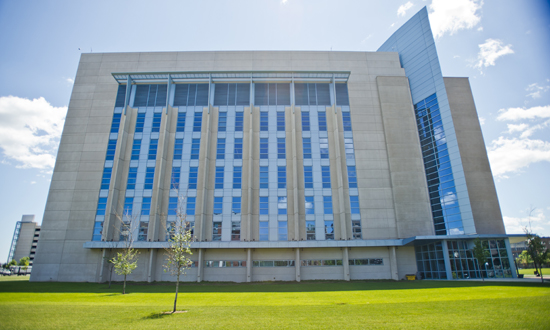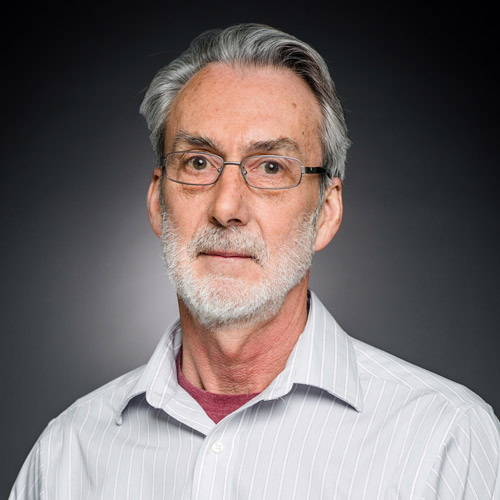NIH: Biosafety Lab Risks Negligible
Clears way to petition regulators for new permissions

The National Institutes of Health issued a final report July 6 asserting that the risk is very low that an infection arising at NEIDL would spread to the community. Photo by Kalman Zabarsky
After eight years of debate, legal challenges, and repeated scientific analyses of the risks of conducting research involving disease-causing microbes at the National Emerging Infectious Diseases Laboratories (NEIDL) on the Medical Campus, the National Institutes of Health (NIH) issued a final report on Friday asserting that the risk is very low that an infection arising in the facility would spread to the community. The 1,700-page report, which was commissioned by the NIH under the advisement of a panel of 16 experts, analyzed the risk of both lab accidents and malevolent acts. The publication of this report moves the lab one step closer to approval for more expanded research.
Ara Tahmassian, BU associate vice president for research compliance, says the scope and scale of Friday’s risk assessment is evidence that the NIH has “looked very carefully at a number of scenarios and concerns that the community has raised, and they analyzed each one of them based on the best information available, and concluded that the risks to the community are negligible.”
“More importantly,” says Tahmassian, “the National Research Council, the same people who were critical of an earlier risk assessment, have labeled this as scientifically sound. That should allay the concerns of the community with regard to the safety issues.”
The lab was given clearance in December 2011 by the Massachusetts Executive Office of Energy and Environmental Affairs to conduct research at Biosafety Level 2 (BSL-2), and the University is seeking a permit that would allow it to pursue judicial and regulatory approval to conduct research at Biosafety Levels 3 and 4.
Biosafety levels are assigned based on primary risk criteria, including infectivity, severity of disease, availability of treatments or vaccines, and the nature of the work being conducted. Each level of containment describes appropriate laboratory practices, safety equipment, and policies for conducting research with a particular agent. The policies are in place to protect researchers, nonlaboratory occupants of the building, the public health, and the environment.
Stephen Burgay, BU senior vice president for external affairs, says the report, titled Final Supplementary Risk Assessment for the Boston University National Emerging Infectious Diseases Laboratories, is not in itself a green light for research at Biosafety Levels 3 and 4. “This is a milestone,” says Burgay. “It is not the final step in the approval process. This will allow us to go to the regulators and courts and ask for the certification needed for research at other biosafety levels.”
According to the NIH report, investigators examined the likelihood and consequences of 300 events, including needlestick accidents, a centrifuge aerosol release, an earthquake, transportation accidents, and malevolent acts. They looked at the number of people who would be exposed and the level of exposure in terms of pathogens. Investigators concluded that the risk of infections or deaths resulting from accidents or malevolent acts at the NEIDL are generally very low to only remotely possible. That finding, the NIH reports, was “largely due to the safeguards built into the facility, the low amounts of pathogens that will be present, and the culture of biosafety and training that will be integrated into everyday practice at the NEIDL.”
The risk assessment concludes that the chances of an undetected or unreported exposure from a needlestick injury are between one in 100 years and one in 10,000 years, and the chances of one or more infections in the general public resulting from total collapse caused by an earthquake are one in a million for three of the four pathogens studied and between one in 10,000 and one in a million for the fourth, Rift Valley fever virus.
Burgay says the NIH risk assessment also considered the question of whether it would be safer to conduct BSL-3 and 4 research at a suburban or rural location, “and concluded that the differences in the sites are minimal.”
Construction on the $200 million NEIDL was completed in September 2008, but controversy and litigation surrounding the study of agents requiring the highest biosafety level, or BSL-4, kept the building’s 192,000 square feet of laboratory space closed until earlier this year, when it opened after being approved for BSL-2 research. Research at that level, as well at BSL-3, is conducted at dozens of labs throughout the commonwealth, including BU.
The BSL-2 research now under way is focused on finding better ways to prevent TB, which kills more than two million people every year. Biosafety lab scientists are not working with the organism that causes TB, but with M. smegmatis, a relative of that organism that might provide clues to how key gene-control mechanisms work. Another project is exploring how host resistance to the TB bacteria works, with an eye toward improving the potency and safety of vaccines.
Burgay says there will be no classified or secret research conducted at the biosafety lab. He says descriptions of all research conducted at the lab will be posted on the NEIDL website.
“All research at any BSL level will be transparent to the public,” he says. “All research proposals will be approved by the Boston University Institutional Biosafety Committee (IBC), which includes senior-level research scientists, environmental health and safety administrators, and two community representatives. The NEIDL Community Liaison Committee, which is composed of six community representatives, will review research proposals and provide input on community concerns. All minutes of the meetings of the IBC are public and available on the Boston University website.”

Comments & Discussion
Boston University moderates comments to facilitate an informed, substantive, civil conversation. Abusive, profane, self-promotional, misleading, incoherent or off-topic comments will be rejected. Moderators are staffed during regular business hours (EST) and can only accept comments written in English. Statistics or facts must include a citation or a link to the citation.